Information Theory for Machine Learning
Massimiliano Tomassoli
(reverse(5102mnhuik)@gmail.com)
05/22/16
Contents
1 Introduction
I The theory
2 Mean or Expected Value
3 Entropy
4 Entropy and Codes
4.1 Can we do better? . . . . . . . . . . . . . . . . . . . . . . . . . .
5 Logarithm and probabilities
6 Jensen’s Inequality
6.1 Convexity . . . . . . . . . . . . . . . . . . . . . . . . . . . . . . .
6.2 Definition and proof of Jensen’s Inequality . . . . . . . . . . . . .
7 Maximum Entropy
8 Specifying the distribution
9 Chain rule
10 Cross Entropy
11 Kullback-Leibler Divergence
12 Mutual Information
12.1 Definition . . . . . . . . . . . . . . . . . . . . . . . . . . . . . . .
12.2 Alternative formulation and interpretation . . . . . . . . . . . . .
12.3 Mutual Information VS Correlation . . . . . . . . . . . . . . . . .
12.4 Linear Regression . . . . . . . . . . . . . . . . . . . . . . . . . . .
1
2
3
3
9
9
11
12
14
14
15
17
19
19
20
21
22
22
24
24
25
�
13 A Set Theoretic view of Information Theory
13.1 The Inclusion Exclusion Principle . . . . . . . . . . . . . . . . . .
13.2 Cardinality of Intersections
. . . . . . . . . . . . . . . . . . . . .
13.3 Multiple Mutual Information . . . . . . . . . . . . . . . . . . . .
13.4 KL Divergence and Total Correlation . . . . . . . . . . . . . . . .
26
27
30
31
37
II Applications of Information Theory to Machine Learn-
ing
38
14 Loss function:
from KL Divergence to Cross Entropy to Log
Likelihood
14.1 Supervised Learning . . . . . . . . . . . . . . . . . . . . . . . . .
14.2 Density Estimation . . . . . . . . . . . . . . . . . . . . . . . . . .
15 Feature selection
15.1 Information Gain . . . . . . . . . . . . . . . . . . . . . . . . . . .
15.2 Joint Mutual Information . . . . . . . . . . . . . . . . . . . . . .
16 EM Algorithm
16.1 Bonus . . . . . . . . . . . . . . . . . . . . . . . . . . . . . . . . .
16.2 Definition . . . . . . . . . . . . . . . . . . . . . . . . . . . . . . .
16.3 Example . . . . . . . . . . . . . . . . . . . . . . . . . . . . . . . .
17 EM Algorithm: why does it work?
17.1 The MM Algorithm . . . . . . . . . . . . . . . . . . . . . . . . .
17.2 EM is an instance of MM . . . . . . . . . . . . . . . . . . . . . .
17.3 Information Theory interpretation . . . . . . . . . . . . . . . . .
38
38
39
40
41
41
42
42
42
43
45
45
46
48
Introduction
1
Students of Machine Learning are usually introduced to Information Theory
through brief tutorials which are too superficial to really understand what’s
going on. One could always read a specialized book, but this might prove
too much of an effort for someone who doesn’t intend to become an expert in
Information Theory.
This tutorial wants to be a reasoned exposition where everything follows
logically from what precedes it. I hope I succeeded in that.
Because of the intended audience, some theorems are presented without
proof but are thoroughly explained to give a solid intuition of why they’re true.
2
�
To make this tutorial self-contained, I took the liberty of proving some clas-
sical results such as the Inclusion Exclusion Principle and Jensen’s Inequality
as I needed them to prove other results.
Moreover, I decided to conclude this tutorial with two sections about the
celebrated EM Algorithm which I think everyone should know even if they’re
just interested in, say, Deep Learning.
I didn’t throw in the EM Algorithm
just for the fun of it: there’s an interesting, if not strong, connection with
Information Theory.
A warning: every derivation is my own so keep your eyes open and let me
know if you find any mistakes!
Part I
The theory
2 Mean or Expected Value
Before we dive into Information Theory, we’d better review the definition and
some important properties of the mean or expected value. We’ll be focusing on
the case of finite discrete random variables here, i.e. random variables which
take only a finite number of values. For the infinite case there are some subtleties
about convergence. Also, for the continuous case one just have to replace all
the sums with integrals.
Definition 1. Let X be a discrete random variable with distribution p. The
mean of X is defined as
EX∼p[X] =
p(x)x.
Remark 1. When there is no ambiguity, we can drop the distribution, the vari-
able, or both:
EX∼p[X] = EX [X] = Ep[X] = E[X].
x
Definition 2. With a slight abuse of notation, if X is a random variable, we
also see X as the set of values which X can take so that we can write, for
instance, ∀x ∈ X, p(x) ∈ [0, 1].
Definition 3. If X is a random variable and f a function, then Z = f (X) is a
random variable such that, for all z,
p(z) = P (Z = z) = P (f (X) = z) = P (X ∈ f−1(z)) =
p(x).
x:f (x)=z
Proposition 1. Let X be a random variable of distribution p and let f be a
function. The mean of the random variable f (X) can be evaluated as follows
Ef (X)[f (X)] = EX [f (X)] =
p(x)f (x).
x
3
�
Proof. Let Z = f (X) and let q be the distribution of Z. Then,
Ef (X)[f (X)] = EZ[Z]
z
z
x
z
z
=
=
=
=
=
q(z)z
x:f (x)=z
x:f (x)=z
z
p(x)
p(x)z
p(x)f (x)
x:f (x)=z
p(x)f (x) = EX [f (X)].
{x1, x2, . . . , xn} =
Note that the double sum can be replaced with a single sum over x because
z{x|f (x) = z}.
···
Definition 4. We can generalize definition 1 by considering a list of random
variables X1, . . . , Xn:
EX1,...Xn [f (X1, . . . , Xn)] =
p(x1, . . . , xn)f (x1, . . . , xn).
Definition 5. If X1, . . . , Xn are random variables, we can define a correspond-
ing vector random variable as
x1
xn
X = (X1, . . . , Xn) = [X1 ··· Xn]t.
Proposition 2. If X = (X1, . . . , Xn) and Y = (Y1, . . . , Ym) are vector random
variables, i.e. vectors of random variables, then
p(. . . , x, . . .) = p(. . . , x1, . . . , xn, . . .)
p(. . . , x, . . .| . . . , y, . . .) = p(. . . , x1, . . . , xn, . . .| . . . , y1, . . . , ym, . . .),
where x = (x1, . . . , xn) and y = (y1, . . . , yn).
Proof. Let’s try not to be too technical. We’ll indicate events by writing predi-
cates between curly braces. For instance, the event “X takes value x” is written
as {X = x}. Now note that
p(x, y) = p(X = x, Y = y) = P ({X = x} ∩ {Y = y}),
which means that p(x, y) is really the probability of the intersection of the two
events {X = x} and {Y = y}. Therefore, since
X = x ⇐⇒ Xi = xi, i = 1, . . . , n,
4
�
then
which means that
{X = x} = {X1 = x1} ∩ ··· ∩ {Xn = xn},
p(. . . , x, . . .) = P (··· ∩ {X = x} ∩ ··· )
= P (··· ∩ {X1 = x1} ∩ ··· ∩ {Xn = xn} ∩ ··· )
= P (. . . , x1, . . . , xn, . . .).
So, basically, a comma in these expressions means “and” or “intersection”. The
proof for p(. . . , x, . . .| . . . , y, . . .) is analogous.
Remark 2. Thanks to proposition 2, we can always simplify notation by writing
just “X” or “x” instead of “X1, . . . , Xn” or “x1, . . . , xn”, respectively, and we can
generalize results by doing the opposite. For instance,
EX [f (X)] =
p(x)f (x)
···
x
implies the generalization
EX1,...,Xn [f (X1, . . . , Xn)] =
p(x1, . . . , xn)f (x1, . . . , xn).
x1
xn
Note that, to be precise, the f in the generalization is not exactly the same
as the f in the simple case, but we won’t be afraid of abusing notation when
convenient.
Definition 6. The mean of a vector random variable X = (X1, . . . , Xn) is
defined as
E[X] = (E[X1], . . . , E[Xn]).
In general, if M is an m × n matrix random variable, then
[E[M ]]ij = E[Mij]
i = 1, . . . , m, j = 1, . . . , n.
Proposition 3. The mean of a constant is equal to the constant itself.
Proof. A constant c can be seen as a random variable X which takes the value
c with probability 1. Thus,
E[c] = EX [X] =
p(x)x = c.
Proposition 4. E[·] is linear.
x
5
�
EX [a + bX] = EX [f (X)]
x
x
=
=
p(x)f (x)
p(x)(a + bx)
Proof. If X is a random variable, a, b two constants, and f (x) = a + bx, then
= a
p(x) + b
p(x)x
x
= a + bEX [X].
x
Proposition 5. Let X, Y be two random variables. Then
EX,Y [f (X)] = EX [f (X)].
In general, we can drop any random variable the argument to the mean doesn’t
depend on.
Proof. This is easy:
EX,Y [f (X)] =
=
=
=
x
x
x
y
y
p(x, y)f (x)
p(x)p(y|x)f (x)
p(x)f (x)
p(y|x)
y
p(x)f (x) = EX [f (X)].
x
For the general case, we can consider an arbitrary sequence X1, . . . , Xn of ran-
dom variables and prove that we can drop the first variable which doesn’t appear
in the argument to the mean. Since n is finite, by repeating this process we must
be left with a sequence Xi1, Xi2, . . . Xik of random variables which all appear in
the argument to the mean.
Remark 3. Thanks to property 5, we can adopt the convention that if X1, . . . , Xn
are random variables and f is a function which depends on all of them and them
alone, then we can write
E[f (X1, . . . Xn)] = EX1,...,Xn [f (X1, . . . , Xn)].
6
�
Remark 4. Given the notation and the conventions we established, we can easily
conclude that, if L is linear, then E[·] ◦ L = L ◦ E[·]. Indeed,
p(x)L(x)
=
L(p(x)x)
x
x
(E[·] ◦ L)(X) = E[L(X)] =
For instance, if L(X1, . . . , Xn) = n
n
n
variables and a1, . . . , an constants, then
(E[·] ◦ L)(X1, . . . , Xn) = E
= L
i=1
x
aiXi
= L(E[X]) = (L ◦ E[·])(X).
p(x)x
i=1 aiXi, where X1, . . . , Xn are random
aiE[Xi] = (L ◦ E[·])(X1, . . . , Xn),
=
i=1
by defining E[·](X1, . . . , Xn) = (E[X1], . . . , E[Xn]).
We can clean things up by using vectors.
[a1, . . . , an]T , then our example becomes
If X=[X1, . . . , Xn]T and a =
(E[·] ◦ L)(X) = E[aT X]
= aT E[X] = (L ◦ E[·])(X).
Definition 7. Let X, Y be two random variables and f a function. The condi-
tional mean of f (X, y) with respect to X given Y is defined as
EX|Y [f (X, y)] =
p(x|y)f (x, y),
x
where y is any fixed real number and not a random variable, so we could define
a new random variable as Z = EX|Y [f (X, Y )]. Note that we didn’t write y, but
Y this time. A more explicit way to write it would be Z = EX|Y [f (X,·)](Y ),
which makes it clear that we’re transforming the variable Y through the function
y → EX|Y [f (X, y)].
Proposition 6. If X, Y are two random variables, then
EX|Y [f (X, Y )] .
EX,Y [f (X, Y )] = EY
7
�
Proof. The proof is easy:
EX,Y [f (X, Y )] =
=
=
x
x
y
= EY
y
y
p(x, y)f (x, y)
p(x|y)p(y)f (x, y)
EX|Y [f (X, Y )] .
EX|Y,C[f (X, Y, c)] .
p(x|y)f (x, y)
p(y)
x
Proposition 7. If X, Y, C are random variables, then, for any fixed c,
EX,Y |C[f (X, Y, c)] = EY |C
This is just a generalization of proposition 6.
Proof. This proof can be derived from the proof of proposition 6 just by adding
“|C”, “|c” and “, c” in the right places:
EX,Y |C[f (X, Y, c)] =
=
=
x
x
y
p(x, y|c)f (x, y, c)
EX|Y,C[f (X, Y, c)] .
p(y|c)
x
y
p(x|y, c)p(y|c)f (x, y, c)
p(x|y, c)f (x, y, c)
y
= EY |C
Corollary 1. If X, Y are independent random variables, then
Proof. First of all, because X, Y are independent, in general, for any fixed y,
Now we can conclude the proof:
EX,Y [XY ] = EY
EX,Y [XY ] = EX [X]EY [Y ].
EX|Y [f (X, y)] =
=
p(x|y)f (x, y)
p(x)f (x, y)
x
x
8
= EX [f (X, y)].
EX|Y [XY ]
= EY [EX [XY ]]
= EY [Y EX [X]]
= EX [X]EY [Y ].
�

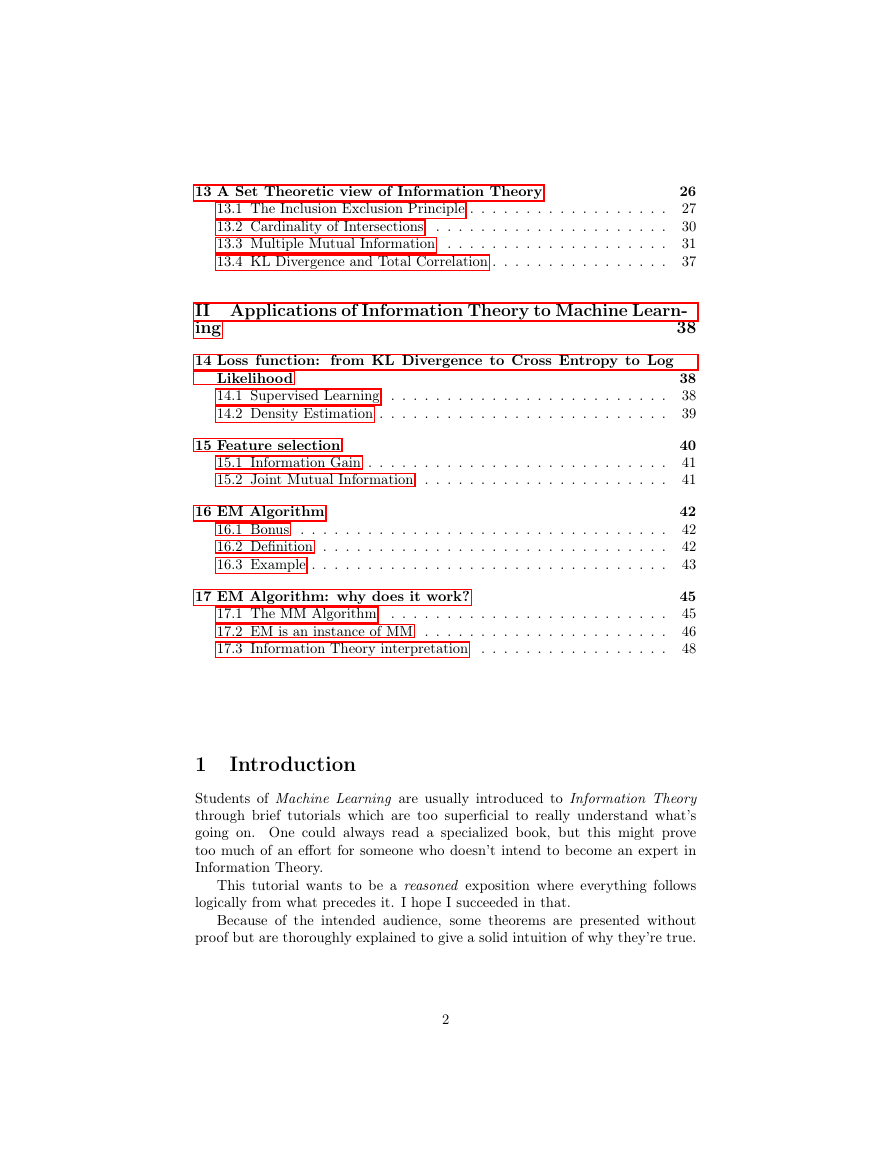
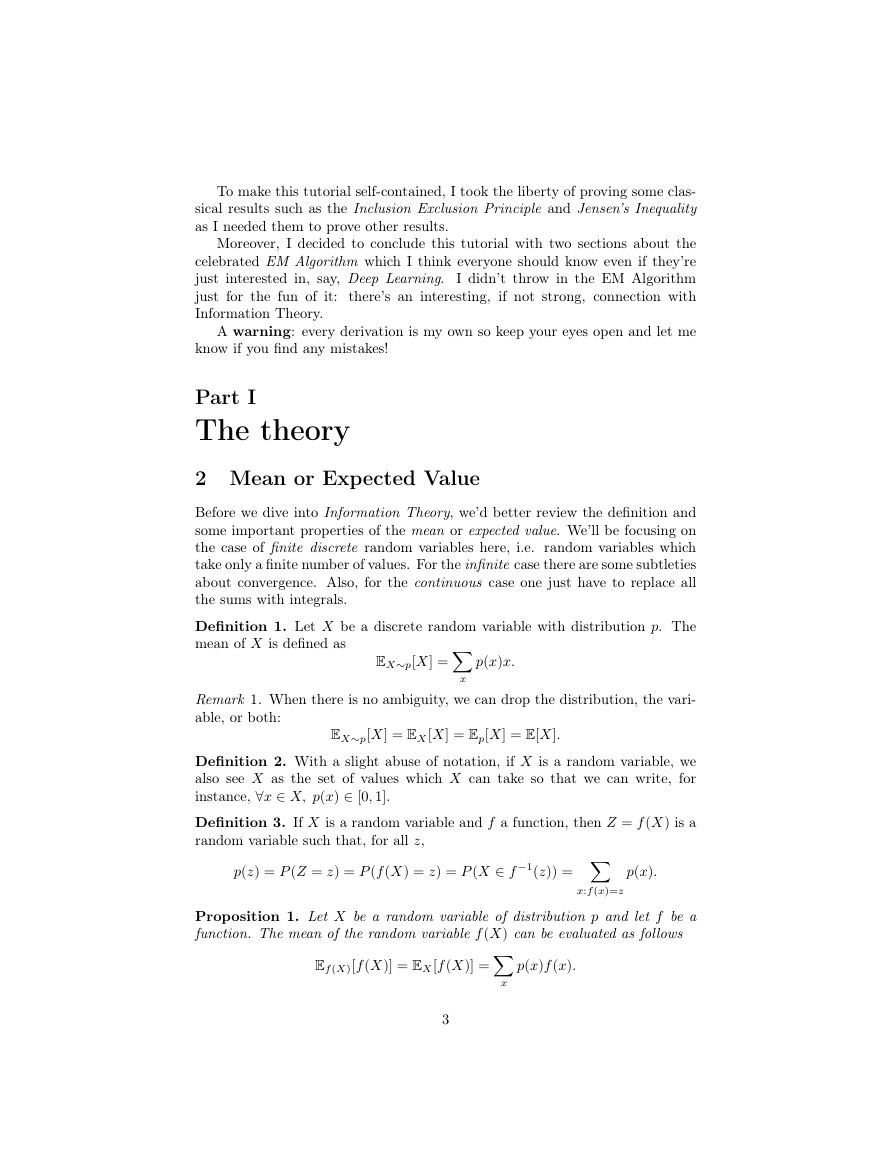
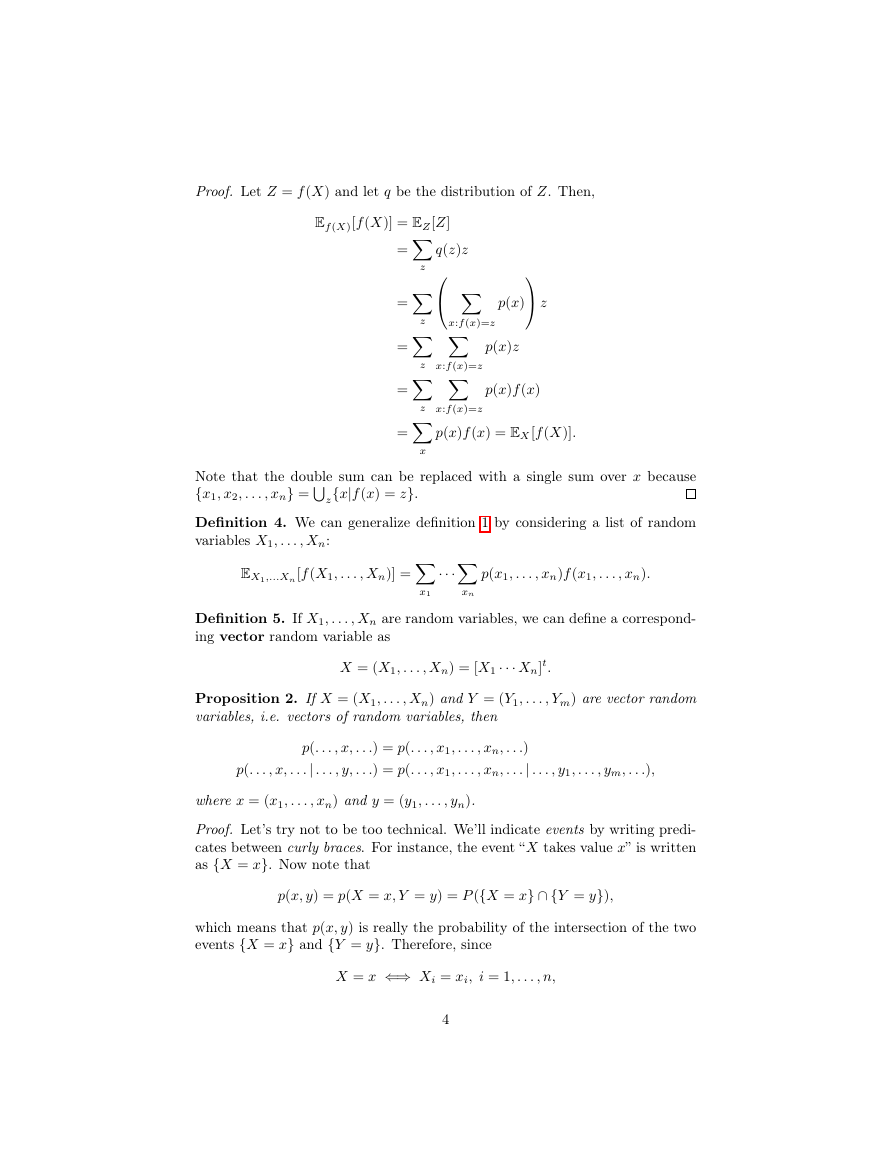

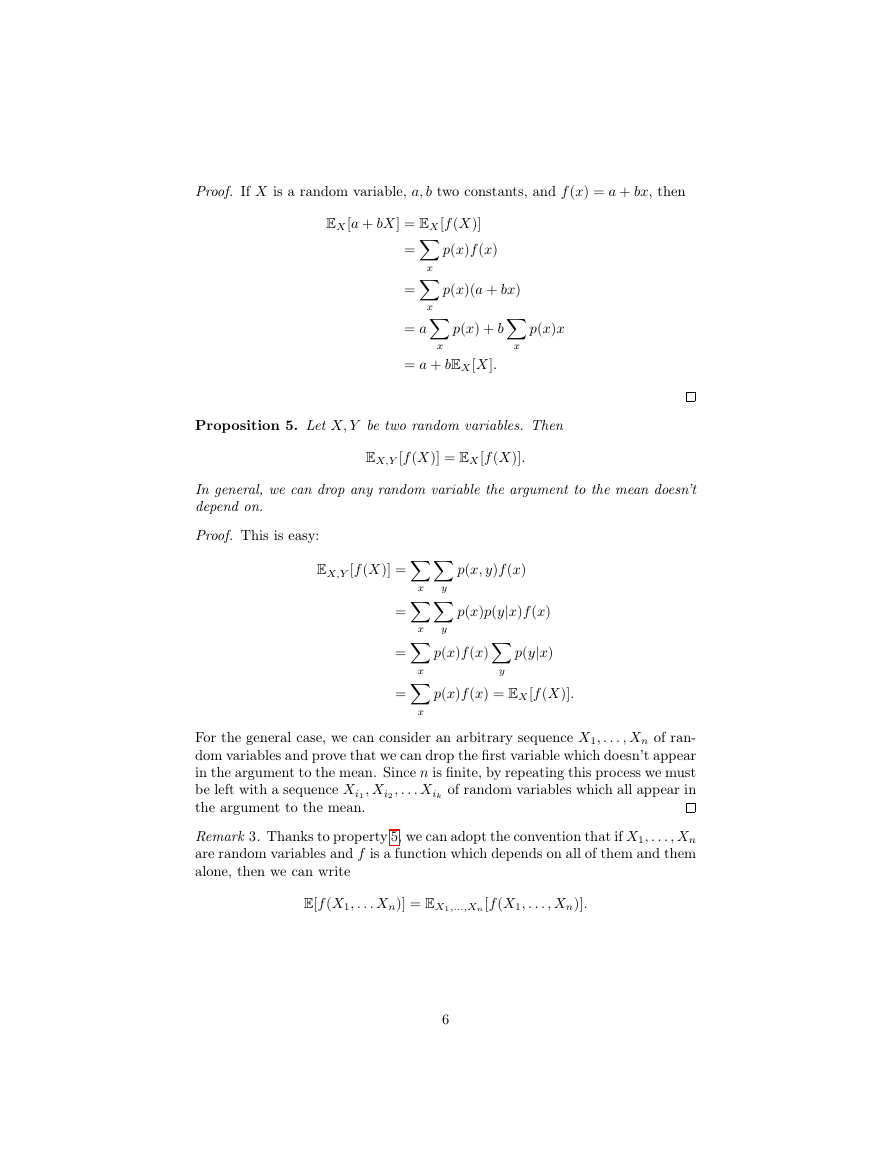
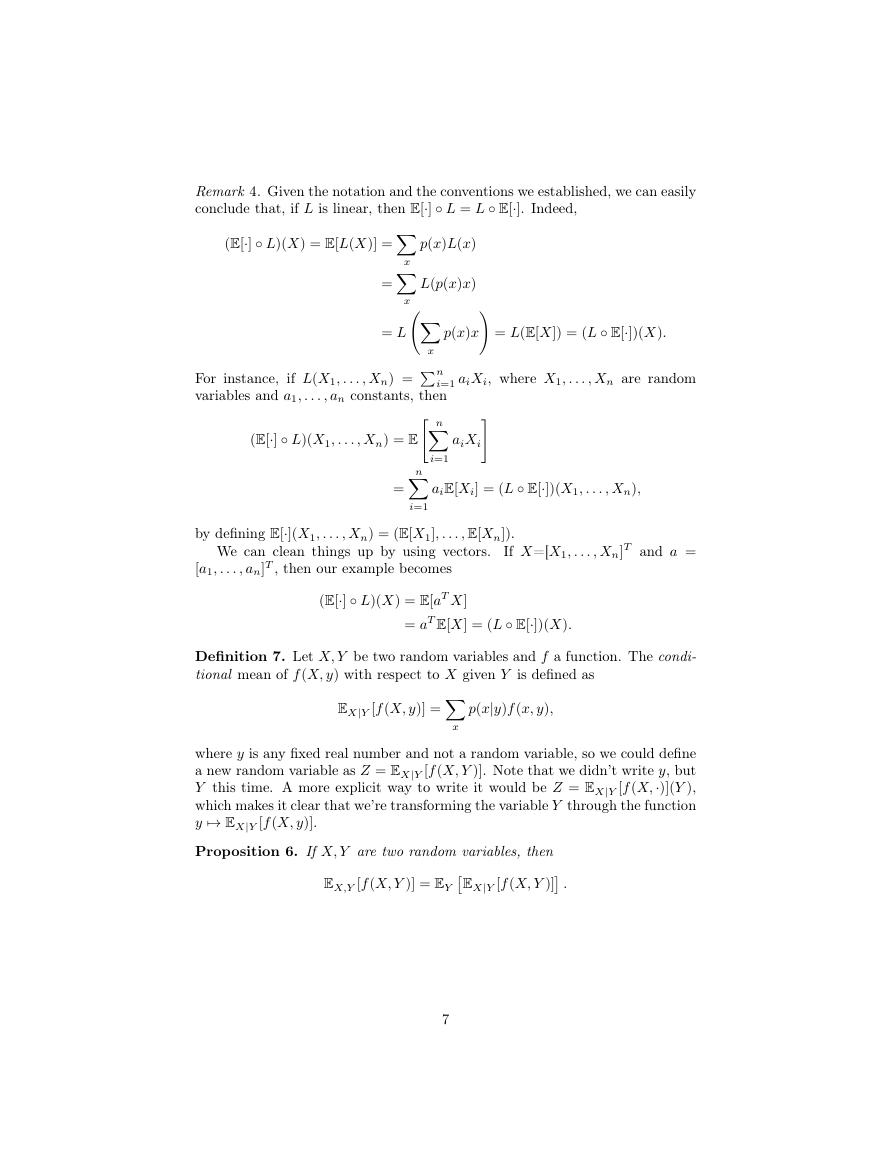









 2023年江西萍乡中考道德与法治真题及答案.doc
2023年江西萍乡中考道德与法治真题及答案.doc 2012年重庆南川中考生物真题及答案.doc
2012年重庆南川中考生物真题及答案.doc 2013年江西师范大学地理学综合及文艺理论基础考研真题.doc
2013年江西师范大学地理学综合及文艺理论基础考研真题.doc 2020年四川甘孜小升初语文真题及答案I卷.doc
2020年四川甘孜小升初语文真题及答案I卷.doc 2020年注册岩土工程师专业基础考试真题及答案.doc
2020年注册岩土工程师专业基础考试真题及答案.doc 2023-2024学年福建省厦门市九年级上学期数学月考试题及答案.doc
2023-2024学年福建省厦门市九年级上学期数学月考试题及答案.doc 2021-2022学年辽宁省沈阳市大东区九年级上学期语文期末试题及答案.doc
2021-2022学年辽宁省沈阳市大东区九年级上学期语文期末试题及答案.doc 2022-2023学年北京东城区初三第一学期物理期末试卷及答案.doc
2022-2023学年北京东城区初三第一学期物理期末试卷及答案.doc 2018上半年江西教师资格初中地理学科知识与教学能力真题及答案.doc
2018上半年江西教师资格初中地理学科知识与教学能力真题及答案.doc 2012年河北国家公务员申论考试真题及答案-省级.doc
2012年河北国家公务员申论考试真题及答案-省级.doc 2020-2021学年江苏省扬州市江都区邵樊片九年级上学期数学第一次质量检测试题及答案.doc
2020-2021学年江苏省扬州市江都区邵樊片九年级上学期数学第一次质量检测试题及答案.doc 2022下半年黑龙江教师资格证中学综合素质真题及答案.doc
2022下半年黑龙江教师资格证中学综合素质真题及答案.doc